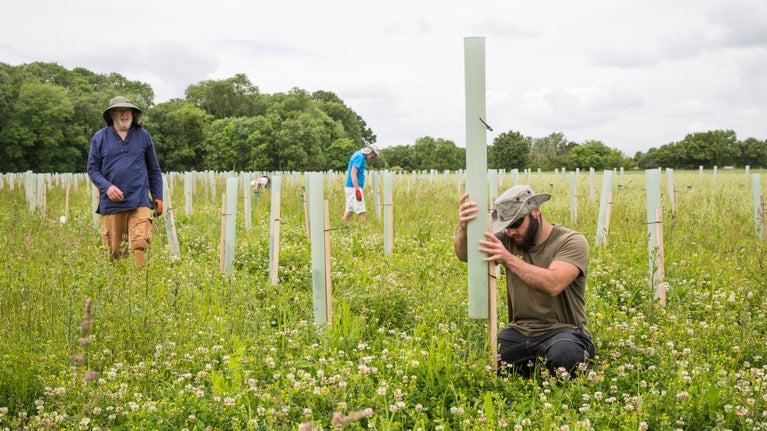
Tackling climate change
Uncover how we’re responding to the changing climate at places in our care.

Warroch Hill, a marginal 1,069-acre hill farm in the Ochil Hills of Perthshire, had been used for low intensity livestock grazing for decades. Learn how the farmland owned by the Church Commissioners for England become a new woodland and why it won an award for its work.
Warroch Hill, a marginal 1,069-acre hill farm in the Ochil Hills of Perthshire, had been used for low intensity livestock grazing for decades. It was identified as land with high potential for woodland creation which would deliver multiple benefits, including production of construction-grade timber and improvements for biodiversity, landscape, and amenity value.
An extensive range of environmental, wildlife and impact surveys were undertaken to establish any site sensitivities, including surveys for birds, rare vegetation and archaeological remains. The new woodland was designed to meet the UK Forestry Standard, ensuring key elements of sustainability were met in relation to biodiversity, climate change, historic environment, landscape, people, soil, and water.
Planting was undertaken in two phases – in 2014 and 2020 – creating an aggregate 819 acres of new woodland, of which 157 acres are a variety of native broadleaves and open ground. In total, over 750,000 new trees were planted. A small area of peat at the very top of the hill was left unplanted for carbon retention.
The Warroch Hill woodland creation scheme was one of the first to provide a specific diffuse pollution plan to mitigate against the potential for diffuse pollution into nearby Loch Leven. As part of the works, existing private water supplies were augmented in collaboration with the local residents.
As testament to the quality of woodland establishment, Warroch Hill won the James Jones Trophy at Scotland’s Finest Woods Awards in 2015 for best new commercial woodland planting in Scotland. The woodland is certified through UK Woodland Assurance Standard, an independent certification standard for verifying sustainable woodland management. Any trees harvested in the future will be certified by FSC as sustainably produced and will aim to maximise long-life carbon sequestration in construction-grade timber, reducing reliance on imported timber. New trees will be planted in their place to ensure a sustainable, renewable supply.
This is a case study linked to the Climate and Land Summit hosted by the National Trust at the Wimpole Estate, in Cambridgeshire, on October 12, 2021, before the UN's annual climate conference COP26 in Cornwall in November that year.
Attendees at the summit represented some of England’s largest landowners and managers, and signed up to six guiding principles to commit to collectively working towards the nation’s net zero aims and pressing needs to adapt to a rapidly changing climate. To read the text of the Compact click here.

Uncover how we’re responding to the changing climate at places in our care.

The Church Commissioners for England is a body that administers the property assets of the Church of England.
Learn about the six climate and nature-based targets discussed at the Climate and Land Summit and how the solutions are being applied at National Trust places.

With support from the Government’s Green Recovery Challenge Fund, we're looking for ways to protect our environment and combat climate change. Find out more about the work we're doing.

From tips on saving water to combatting plastic pollution, learn more about our work to protect precious coasts and rivers for wildlife and people, and what you can do to help.

Discover the vital ways peat supports the environment, from carbon store to archaeological record, and see some of our key projects protecting and restoring the peatland in our care.

We’re tackling the threats of a changing coastline to safeguard the places you love. Find out how our teams are adapting their approach to our shifting shores.

Discover more about the National Trust’s role at COP26 in Glasgow and how you can help tackle the climate crisis.
